Zombies Take Manhattan in Citywide Walking Dead Activations
Posted in: UncategorizedThe Walking Dead: Dead City returns for Season 2 on May 4.
The Walking Dead: Dead City returns for Season 2 on May 4.
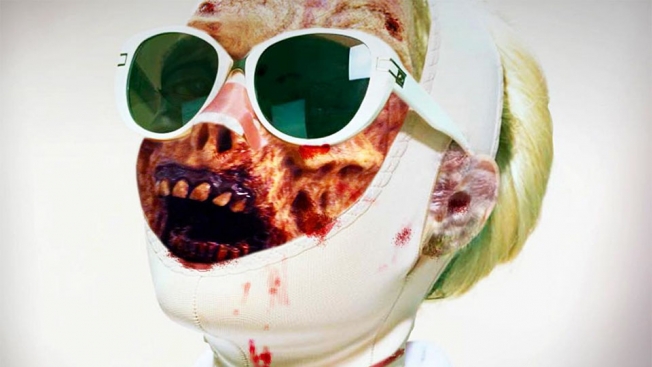
“Just what Los Angeles needs. Fewer brains.”
Unfortunately, that’s not a tagline for Fear the Walking Dead, which premieres this Sunday on AMC as the second series in the cable-television-eating Walking Dead zombie franchise.
Rather, it’s a line from two freelance L.A. creative directors, Charlie Noback and Brian Engleman, who are launching an Instagam called Cheer the Walking Dead. The idea is simple: Celebrate the arrival of the undead in their fair city by zombifying classic L.A. images.
They’ve posted half a dozen so far, and are hoping to get submissions (via email) from other creatives. “There are so many overworked ad professionals right now, sometimes I think we’re the real zombies,” says Engleman.
But mocking up L.A. zombie scenes can be nourishing for the soul, and clean out those festering creative minds, can it not? Says Noback: “I hope by getting the word out, we’ll help turn some zombies back into ad professionals.”

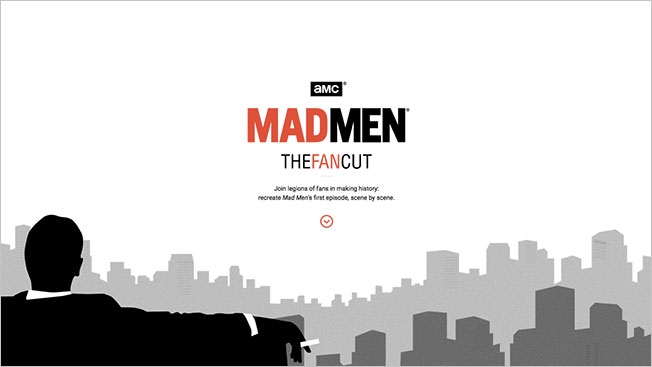
Ahead of Mad Men’s final episodes on AMC this spring, the series has launched The Fan Cut, a contest that lets would-be auteurs remake scenes from the show’s pilot episode in (almost) any way they see fit.
That first episode has been cut up into some 154 clips ranging from 8 to about 40 seconds long. Up to five fans can “claim” each scene, and they have 30 days to create and upload their own versions. Ultimately, the entire pilot will be re-assembled and screened online based on select submissions.
The rules warn us: “Any depiction of consuming alcohol or smoking tobacco should be simulated.” (The crew behind the camera, presumably, can get as sloshed as they like.) And just in case any wisenheimers get ideas about crashing this bash and bragging about it to the ad blogs, the inclusion of third-party brands is strictly prohibited. (But if you do manage to sneak in a plug for a real client, be sure to tell AdFreak about it first!)

On the one hand, The Fan Cut is a creative way to connect with the landmark show and puts a sort of reverse spin on breaking through the fourth wall, letting the audience do it instead of the cast. On the other, it’s a huge waste of time, just like the ad business itself!
Kidding, of course. The competition promises to be a ton of fun and should yield some intriguing, and possibly insane entries. Look for anime Don, emoji Pete and sock-puppet Peggy. I’m also expecting scenes featuring helium-voiced stand-ins for the regular cast, along with cuddly puppies and adorable babies.
![]()
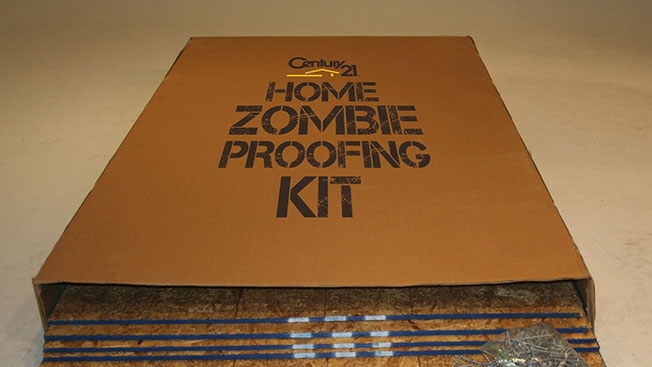
It’s nothing fancy—just some particle boards and nails. But it ought to keep out those bloodthirsty zombies.
Yes, just in time for this weekend’s return of The Walking Dead to AMC, Century 21 (with help from the little mad scientists at its social agency, Mullen) is auctioning off a “Home Zombie Proofing Kit” on eBay.
Here’s part of the description on eBay.
• Strong enough to withstand hurricane force winds or prying dead fingers.
• Sealing prevents edge swell from liquid damage or tainted blood.
• Galvanization guaranteed to outlast even long-lasting outbreaks.
CAUTION: Loud noises caused by installation of Century 21 Zombie Proofing Kit may attract more zombies.
Bidding goes until next Wednesday, with all proceeds donated to Easter Seals.
![]()
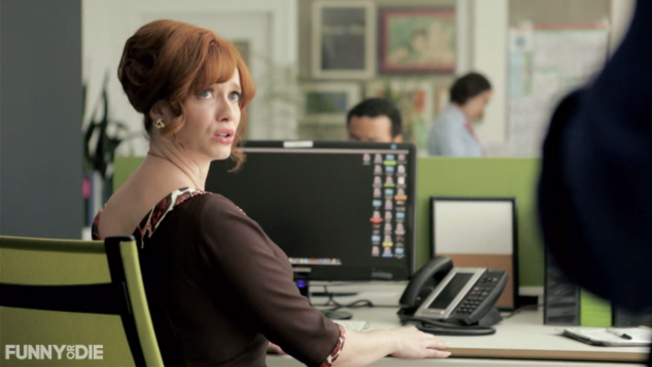
The final half of the seventh and final season of Mad Men won’t premiere until next spring (although filming has wrapped—and according to Elizabeth Moss, there was a lot of crying going on as the cast shot the finale).
For now, Mad Men fans have to snack on whatever measly morsels they can get—like Jon Hamm goofing around on Fallon, or Christina Hendricks trying to navigate a modern office in the Funny or Die video below. And good old Joan, she’s still the sharpest person in the room even when she can’t find the phone.
![]()
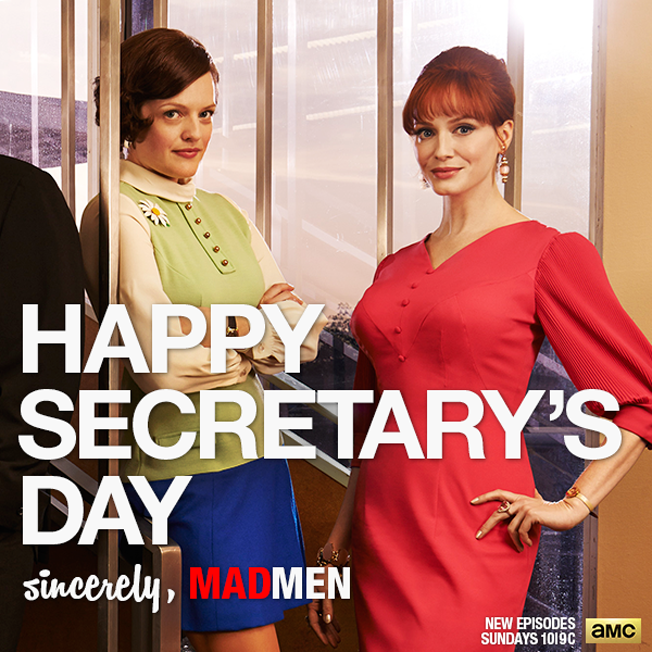
It's Secretary's Day—the more politically correct name is Administrative Professionals' Day. And Mad Men, its feet still set firmly in the '60s, is wishing you a very happy former (with a hashtag nod to the latter).
In a curious move, the AMC show's Twitter account is celebrating the occasion with a photo featuring two former secretaries, Joan and Peggy. Why not use current secretaries Dawn and Shirley, both of whom had interesting arcs in this Sunday's episode?
Did they pick our two female leads from Sterling Cooper & Partners deliberately to show that you too can move up the ranks from secretary (administrative professional) to account man (Joan) or copy chief (Peggy)?
H/T: Gothamist's Jen Carlson.
![]()

If you can't wait for Mad Men to return for part one of its seventh and final season this Sunday, and you're itching to declare your intention to watch it to all your social media friends, AMC would like to offer you a special opportunity to advertise on its behalf by customizing a picture of Don Draper so your name appears next to his face.
You can choose one of seven other characters, too. It's a fun tool for die-hards, and a smart way to drive the natural symbiosis between TV and social media. Dubbing it "Mad Men Out of Office" seems a bit of a misnomer (as much as posting to Facebook may feel like clocking in to some). If you were going to be in the office on a Sunday night, you should obviously quit and watch Mad Men.
Unless you work in advertising, in which case, of course, you probably are in the office on a Sunday night, and you won't be watching Mad Men, or having much use for AMC's widget. You can still drown your woes in Canadian Club, though—and catch up on the first six seasons in two minutes, to remember what you'll be missing.
![]()
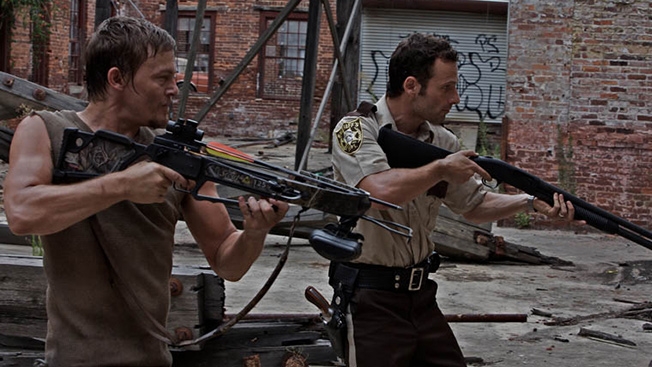
AMC's The Walking Dead is a massive multimedia story line these days, spanning comic books, novels, video games and, of course, the highest-rated series on television. At the epicenter of this sprawling narrative empire is its creator, comic-book writer Robert Kirkman.
So fans were understandably excited this week to see Kirkman offer himself up for a Reddit AMA ("Ask Me Anything") session. Many of his comments had implications not just for the comics he continues to write each month, but also for the show and other extensions that remain loyal to his vision.
We compiled a few of his more interesting responses, which cover everything from his willingness to kill off beloved characters to his complicated feelings on the TV series' high-profile turnover of showrunners:
1. He's not afraid to kill off Rick.
Q: Is Rick Grimes a "safe" character?
A: Absolutely not. Although when I look in Andrew Lincoln's piercing blue eyes, I feel safe.
2. Even Daryl, a popular show-only character played by Norman Reedus, could get killed off.
Q: How does popularity, if at all, affect the survival rate of characters? Have you ever killed a character just because they were popular and you wanted to shake things up?
A: In my opinion, I feel like characters ripen like fruit. So while I wouldn't say the more popular a character is the more likely they are to die; they do have to reach a certain level of popularity before they've "earned" the death. No character is too popular to die. (Suck it, Reedus!)
Q: How's your relationship with Reedus and the rest of the cast? Does it influence their character's fate?
A: It honestly doesn't. Everybody knows the score and everyone knows what they're getting into when they sign on. I think I have a good relationship with all the actors.

3. He supports AMC's decision to fire the first two showrunners but says he was "only on the sidelines."
Q: I was wondering if you could speak at all about the circumstances surrounding the trend of multiple showrunners (Frank Darabont, Glen Mazzara, Scott Gimple) and what you thought each of them brought to the show?
A: Our showrunner musical-chair routine is not entirely uncommon in television. There have been countless shows that have changed showrunners and some even from season to season. It's unfortunate that this show exists under such a microscope and the behind-the-scenes drama has been pushed into the spotlight … but it's a small price to pay for the success that we've had, so I'll take it.
It would be wrong for me to go into any details on the various changeovers because for the most part I was really only on the sidelines during the changes. Although, I will state for the record that I do agree with AMC's decisions in each case and strongly feel they were only acting with the show's best interests in mind.
I think Frank [Darabont] set the show up with a solid foundation to build upon and gave us a directing and visual style for the show that we still use because it's superb and has been a big part of what makes us stand apart on television. This show wouldn't exist without him and his work on the pilot still holds up as one of our strongest episodes. We were lucky to have a director of his caliber involved in the show from day one.
Glen [Mazzara] was a shot in the arm that the show needed in its second season and his instincts to move story up and really heighten the pace at times was a welcome addition to the show. The level of energy he brought to the show is something we still try to maintain. Personally, Glen was very good to me as a novice television writer and I feel that he was a great teacher whose lessons I still use often on the show. I owe him a lot.
Scott Gimple is an absolute rock star. I think that looking back at Season 4 as a whole it is by far our strongest season. The show is intense when it needs to be and slows down and digs into the interpersonal character drama in ways we never achieved without him. Scott's been integral to the show since he came on board for Season 2 and honestly knows more about this world than I do. (And he definitely remembers the ins and outs of the comic book WAY better than me). I think we'll keep him.
4. He hated the CDC episode in Season 1, but not because it was terrible. He felt it gave away too much.
Q: Why did you not like the mention about France (being a last human stronghold) at the CDC in Season 1?
A: I feel it revealed too much of the world and gave the characters too much information. I prefer the way they're more in the dark about the rest of the world in the comic. For instance, for all they know in the comic, the outbreak is contained on this continent.
5. He likes how The Walking Dead video game series by Telltale Games captures the mood of the series without requiring lots of his input.
Q: How much do you have to do with the Telltale seasons of The Walking Dead? I really enjoy them, but damn they're brutal.
A: At this point, I feel like if I got too involved, I'd just screw things up. I was slightly more involved in Season 1, I think, but really it was just a matter of me approving their story when they ran it by me. The team there did an enormous amount of work to get the tone and feel in line with what I do in the comics before they ever came to me.
Before we started Season 2, they asked me a lot about where I was going in the comic and some things they should avoid, and I gave them some notes, but for the most part, those guys have taken the ball and run with it … to what I think we can all agree is great success.
6. But he hates Activision's critically panned game The Walking Dead: Survival Instinct, which he blames on AMC.
Q: Why did you allow them to make Survival Instinct?
A: I'm pretty sure there's an AMC logo before the title of that game and not a picture of my face. If there was a picture of my face in front of the logo, then I'd be completely responsible for that. I can only oversee/be involved in so much … and my efforts were focused more on the Telltale games series.
In all honesty, it was at least cool getting to play Daryl Dixon, right? Right? Come on, guys.
7. Rick's hand wasn't cut off on the TV show because it would require too much CGI and complicate action scenes.
Q: In the Nerdist podcast you said that you wished you hadn't had (*Spoilers*) Rick's hand cut off as it was hard to draw him buttoning up a shirt (and a lot more, but this covers it). When it came time to do the same in the show, you didn't. Was this a financial CGI decision or just a "I get a re-do" decision.
A: To clarify, I think cutting Rick's hand off when we did was great for the comic. It's just that in another medium it would be harder to pull off. We cheat in the comic because things aren't moving. You can't do that on the show. You'd see Rick not being able to reload his gun and things like that.
The CGI of cutting off Rick's hand would be expensive, but we did it with Hershel's leg so if we felt strongly about Rick losing a hand, we'd do it.
8. He has no plans to stop writing The Walking Dead comic books anytime soon.
Q: I remember reading an interview from a while back in which you said you planned on having The Walking Dead span about 300 issues. As of now, is this still the plan for you, or could it continue indefinitely?
A: I do plan on doing at least 300 issues, but if I'm having this much fun, then I won't stop there. Also, if I suddenly start having a lot less fun, I may end it earlier, but I don't see that happening. I'm in for the long haul, and Charlie Adlard is too. As far as a new group/location … not exactly … although there are some really cool changes coming up in issue 127.
For more, read the entire AMA session on Reddit. Also, in case you missed the news, Walking Dead repeats will be coming to broadcast TV with TV-14 edits.
![]()
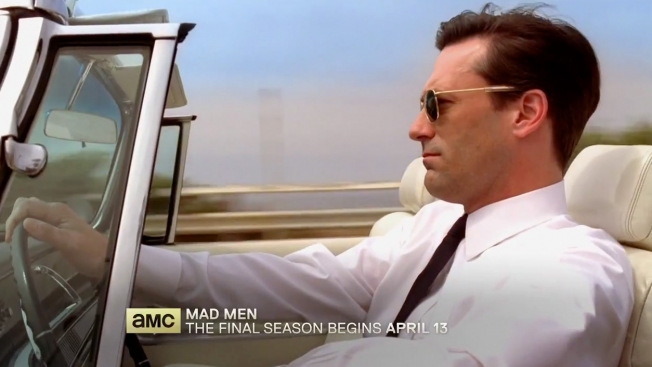
How many times can a two-minute recap of Don Draper's six-season-long journey on Mad Men capture the off-the-rails boozer puking into a potted plant? Zero. But the rest of his repertoire is nicely represented in this short promo video ahead of the Season 7 premiere.
There are the suave drags on cigarettes, highball in hand, the prolific womanizing, the creative genius. AMC, as usual, has been stingy in releasing new material for the upcoming, final season. Hence the look back at Draper's world-by-the-tail early days on Madison Avenue through his infidelities, betrayals, failed marriages and, where fans last saw him, forced sabbatical from his namesake ad agency.
It's not much, since the Season 7 premiere is still six weeks away. But it's a decent, stylized refresher. What would make the April 13 series return not seem so distant? Two-minute Joan, two-minute Peggy, two-minute Bob. Definitely two-minute Bob.
Also, for a deeper dive, check out our archive of Mad Men Minute video recaps of every episode.
![]()
Para promover a quarta temporada de “The Walking Dead”, a AMC realizou uma pegadinha nas calçadas de Nova York.
Zumbis saiam do chão e surpreendiam os pedestres, que tiveram as reações capturadas com cameras escondidas.
O retorno da série acontece no próximo domingo, 9 de fevereiro, nos Estados Unidos.

 Post originalmente publicado no Brainstorm #9
Post originalmente publicado no Brainstorm #9
Twitter | Facebook | Contato | Anuncie
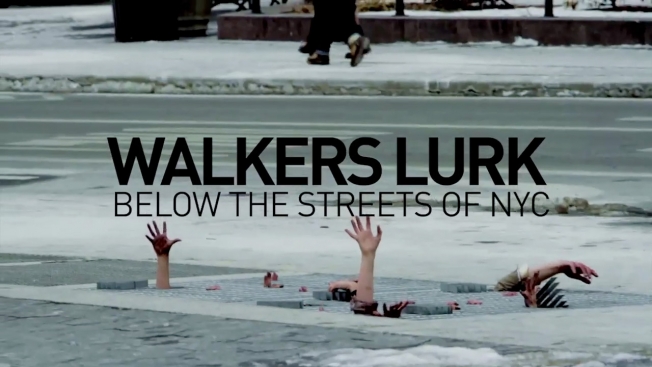
You're walking along the streets of New York City, earbuds firmly in place, texting furiously and doing your best to ignore the press of humanity as it swarms around you … when the monster-movie version of the very horror you're seeking to avoid erupts out of a street grate. It would be enough to make you drop your skinny latte on your skinny jeans.
Score another victory for prankvertising and AMC. For a moment there, I had forgotten about The Walking Dead, which shambles onward, entering its fifth season even as the zombie apocalypse genre is starting to feel like a rotten cliché. The stunt itself, orchestrated by ad agency Relevent, is simple and effective, but there's a surprisingly real and sweet moment when the zombies restrain themselves from scaring the bejesus out of a little girl who wanders up to the grate in curiosity.
Of course, they don't have any reticence about scaring their own cast. Norman Reedus was recently pranked by costar Andrew Lincoln and one-limbed Vine star Nick Santonastasso. They set him up with a fake interview in Tokyo and then sprung the undead on him.
Between those two incidents, and the even more aggressive "Devil Baby Attack" prank for the horror movie Devil's Due, it seems ambushing people in NYC with horrifying half-humans is the strategy of the season. If that's what it takes to breathe life into the zombie genre, then prank on.
Credits below.
CREDITS
Client: AMC
Agency: Relevent
Executive Creative Director: Ian Cleary
Executive Producer: Tony Berger
Creative Director: Jody Feldman
Producer: Bari Henderson
Account Manager: Claire Annas
![]()

Steely-eyed, crossbow-wielding Daryl Dixon never loses his cool in a zombie attack, but the actor who plays him, Norman Reedus? He might just jump out of his skin if set upon by the undead. The Walking Dead star got an unexpected visit from a superfan, transformed into a brain-eating monster by the show's special effects guru Greg Nicotero, during a promo tour for the mega-hit AMC TV series. He reacted in a very un-Daryl-like way.
See the video below, which joyfully (for us) and embarrassingly (for Reedus) replays his jump/yelp in slow motion. Walking Dead fan Nick Santonastasso, 17, has pulled this prank before on unsuspecting grocery shoppers, who defended themselves with bulk paper towels and party supplies. Reedus had only his endearing personality to shield him.
AMC, meanwhile, has just released the newest trailer for the Feb. 9 return of the zombiepocalypse drama. (See that below as well.) The prison is lost, the survivors are scattered and on the move, and everybody, it seems, is losing it. Reedus can relate.
![]()
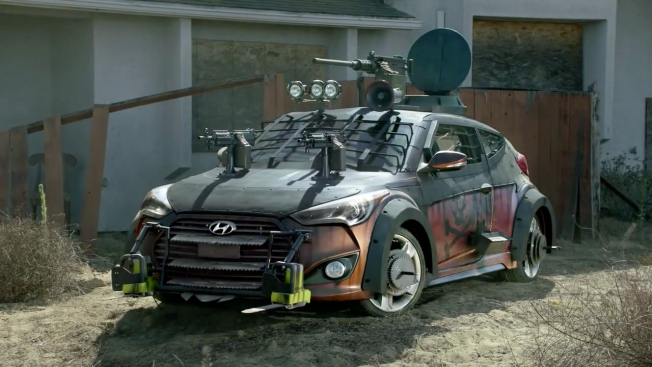
The new ad in Hyundai's ongoing tie-in with AMC megahit series The Walking Dead features a scruffy bunch of zombiepocalyse survivors who could pass for Woodbury refugees taking shelter with Sheriff Rick and crew. That means they'll probably be dead soon. Sharp sticks will get them only so far against angry hordes of walkers and that pesky black cloud that hangs over our heroes.
The latest commercial, from Innocean USA, helped kick off the drama's fourth season this week and launch the next round of Hyundai's Chop Shop initiative. Fans can win a custom-designed, tricked-out, zombie-proof 2014 Hyundai Tucson in the "Survive and Drive" sweepstakes. If it's anything like the inaugural prize, unveiled at the recent New York Comic-Con, there will be razor wire and machine guns.
Hyundai, an early sponsor of The Walking Dead, has to love this killer alliance. The show's Season 4 premiere pulled in a record-busting 16.1 million viewers, up 30 percent from its previous high-water mark. More Chop Shop-centric ads will debut on Hyundai's social media networks within the next few weeks. See the previews below.
CREDITS
Client: Hyundai Motor America
Spot: "Speech"
Agency: Innocean USA
Executive Creative Director: Greg Braun
Creative Directors: Barney Goldberg, Scott Muckenthaler, Tom Pettus
Art Director: Arnie Presiado
Copywriter: Jeb Quaid
VP, Director of Integrated Production: Jamil Bardowell
Executive Producer, Content: Brandon Boerner
Product Specialist: Lawrence Chow
VP, Account Director: Juli Swingle
Account Supervisor: Darcy Tokita
Account Coordinator: Kohl Samuels
VP, Digital Engagement and Strategy: Uwe Gutschow
VP, Media Planning: Ben Gogley
Media Director: James Zayti
Senior Business Affairs Manager: Lisa Nichols
Project Manager: Dawn Cochran
Production Company: Biscuit Filmworks
Director: Mike Maguire
DP: Neil Shapiro
Executive Producer: Colleen O'Donnell
Producer: Tracy Broaddus
Production Supervisor: Mitch Livingston
Casting Agent: Mary Ruth
Editorial Company: Union Editorial
Editor: Jim Haygood
VP Executive Producer: Megan Dahlman
Music Company: Human
Producer: Jonathan Stanford
Telecine Place: Company 3
Online Place: Union Editorial
Record Mix Place: Eleven Sound
![]()
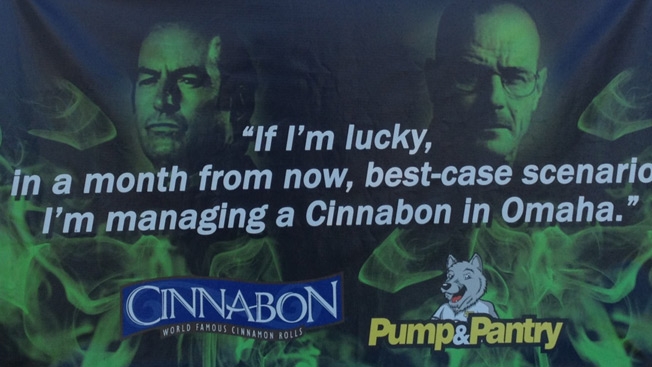
[Mild Breaking Bad spoiler ahead.]
In "Granite State," the penultimate episode of Breaking Bad's final season, Saul Goodman, contemplating his future with a new identity away from New Mexico, makes an offhand reference to a certain cinnamon-roll chain. "If I'm lucky," he says, "in a month from now, best-case scenario, I'm managing a Cinnabon in Omaha."
It took a little while, but naturally, a manager at a Cinnabon in Omaha couldn't let that go without a response.
A spokesperson for Cinnabon confirmed to Consumerist that the sign above, outside an Omaha location, is real and was approved by corporate. It might not be the most stunning creative execution, but kudos to the manager for making the most of what, in the end, wasn't the most flattering reference. (Perhaps he took his cues from the Belize Tourism Board, which earlier in the season embraced a very unflattering mention on Breaking Bad—the use of the phrase "taking a trip to Belize" as a euphemism for getting murdered.)
Cinnabon corporate was quicker to respond to Saul's quip. Check out the tweet below, linking to Cinnabon's careers page, made on the very night "Granite State" aired.
. @mrbobodenkirk When you're ready http://t.co/fynwXF6W9c #BreakingBad
— Cinnabon (@Cinnabon) September 23, 2013
![]()
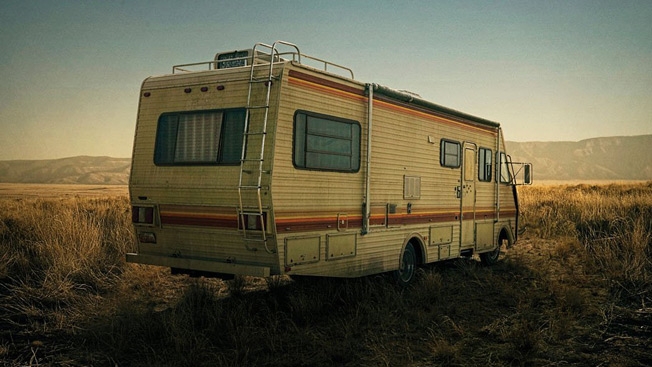
Two shows left, bitches!
AMC's Breaking Bad airs its last episode on Sept. 29, and the network whipped up this print ad promoting the series finale to thank the cast and crew for their efforts over the five seasons of the landmark series. The copy reads, "It was all in the chemistry. Thanks to everyone who made Bad so good." The ad shows the RV where Walter White and Jesse Pinkman cooked meth in the early days. Remember the episode where they couldn't get the clunker started and ended up stranded way out in the desert and nearly died? Yeah, that was a barrel of fun. Appropriately, in this ad, the sun is low in the sky. Indeed, once the series ends, the TV spectrum will be just a bit dimmer.
As for fans who can't let Breaking Bad go, well, they'd better call Saul.
Via THR.
![]()

The full run of Breaking Bad is coming out on Blu-ray soon after the AMC series wraps up. And if you're enough of a fan to spring for the special-edition box set, it's packaged in a replica money barrel. Not only that, it comes with a Los Pollos Hermanos apron and enough special features—a documentary on making the last season, commentaries on every episode, etc.—to choke Jane Margolis. You can pre-order the set on Amazon, but be warned: It costs at least half a money barrel right now.
![]()
Todo mundo tem um amigo que um dia (ou todos os dias) repetiu exaustivamente que você deve assistir “Breaking Bad”. E não é uma simples recomendação, inclua aí doses de histeria: “assista logo!”, “é a melhor série!”, “quem não vê está por fora!”, “se você não assistir sua vida não terá sentido!”, e outras alegações do tipo. Um comportamento talvez, só talvez, um pouco exagerado, e que virou motivo de piada, tipo fã do Iron Maiden, mas que tem fundamento. Eu mesmo fui influenciado assim, e passei os últimos anos recomendando de forma pouco controlada para quem ainda não assistia/assiste, sem vergonha de ser chato. Peço desculpas se fui irritante, mas me dê licença para ampliar o discurso a partir de agora.
O fato é: Quando o último episódio da série for exibido, em 29 de setembro de 2013, não importa se você acompanhou ou não a saga de Walter White e sua família – e nem qual seja o aguardado destino dos personagens – o sarrafo das produções televisivas terá atingido o seu ápice. Pode-se até argumentar que muitos outros programas ainda estão em andamento, e tantos ainda virão, mas o ciclo narrativo e técnico do show da AMC terá impactado as indústrias criativas de forma indelével.
“Breaking Bad” é um exemplo impecável da televisão como forma de arte, competindo em um terreno antes exclusivo do cinema. A mídia televisiva, que por muito tempo foi demonizada como um viciante e alienador antro de programação popular e vulgar, se tornou na última década também sinônimo de cultura e entretenimento adulto de qualidade. Bem, é verdade que a maior parte da TV ainda é recheada de realitys e programas de auditório de gosto duvidoso, mas, quando se fala em dramaturgia, estamos testemunhando uma inversão de papéis entre as emissoras e os estúdios de Hollywood.
Uma revolução criativa que permitiu à TV ter o impacto cultural, o conteúdo autoral e os investimentos antes exclusivos do cinema

Dois livros recentes – “The Revolution Was Televised” de Alan Sepinwall, e “Difficult Men” de Brett Martin – falam dessa revolução criativa e mercadológica que permitiu à TV ter o impacto cultural, o conteúdo autoral e os investimentos que antes eram dominados pelo cinema. Enquanto Hollywood tornou-se conservadora, tentando ser a prova de falhas com uma obsessão crescente por franquias e blockbusters, os canais de televisão assumiram um comportamento rebelde e arriscado. Claro que números importam, mas as emissoras pagas decidiram que, muitas vezes, o buzz e a influência valem mais do que métricas quantitativas de audiência.

Uma das consequências disso como marca é que, em uma época de fragmentação do público, os canais de TV estão conseguindo estabelecer conexão e fidelidade com o espectador, algo que os grandes estúdios de cinema – exceto a Disney/Pixar – não tem. Ninguém espera ansiosamente para ver o próximo filme da Warner Bros. ou da Paramount, por exemplo, esse sentimento depende muito mais do elenco e profissionais envolvidos, mas certamente tem muita gente na expectativa pelo que a HBO, AMC ou Showtime farão a seguir.
Outro ponto que também era tido como exclusivo de Hollywood, e que agora migra para a televisão, é a força dos criadores. Os diretores de cinema sempre foram vistos como as estrelas do show, mas na TV os responsáveis por séries também tem conquistado o status de celebridade, contando com liberdade para controlar todo o processo de produção e sendo reconhecidos por isso.
Cresce também o intercâmbio entre meios, com diretores e atores de filmes atuando na televisão, antes considerada lugar de profissionais de segundo escalão. Aliás, os estúdios é que estão atrás dos ícones das séries para trabalharem em seus filmes. Bryan Cranston ter sido escolhido para viver o novo Lex Luthor, por exemplo, não foi apenas pela careca brilhante.
“Breaking Bad” é prova cabal de todo esse cenário, definindo o ponto mais alto da mídia até o momento e culminando no que Brett Martin chama de “a terceira Era de Ouro da TV”. Porém, não custa lembrar que tudo começou antes. 14 anos antes, para ser exato, com um rechonchudo (quase careca) de roupão e que se encantou com patos na piscina de sua casa.
Apesar de “Oz”, o drama prisional da HBO, ter ido ao ar quase dois anos antes, marcando a entrada em conteúdo original da emissora, a estreia de “The Sopranos” em 1999 é notoriamente tida como a pedra fundamental dessa revolução, onde novos tipos de estórias e estrutura formal permitiria que dezenas de outras séries fossem possíveis no futuro. Vince Gilligan, criador de “Breaking Bad”, afirmou que Walter White não existiria sem Tony Soprano.
David Chase e sua equipe de roteiristas modificaram a arquitetura de storytelling comumente praticada. Nada mais é garantia de final feliz.
Quando David Chase criou um mafioso no divã, que se dividia entre uma rotina de crimes e dedicação familiar, deu vazão ao surgimento de muitos outros anti-heróis. Quebrando convenções, “The Sopranos” mostrava que nada mais era garantia de final feliz. A morte de personagens regulares passou a ser comum, algo antes impensável na TV. Tony Soprano é um protagonista que causa empatia, mas ainda assim violento e assassino, um tipo de personagem que as pessoas viam e gostavam no cinema, mas não aceitavam “dentro de suas casas”.
Além disso, sem a obrigação de saciar o apetite das emissoras de TV aberta por mais e mais episódios, e no menor tempo possível, Chase e sua equipe de produtores e roteiristas modificaram a arquitetura de storytelling comumente praticada. Cada episódio de “The Sopranos” é sólido por si só, mas também faz parte de um arco maior de temporada, e se conectam de forma coerente uns aos outros. Não funciona como uma sitcom, em que você pode ligar a TV e assistir o que estiver passando fora de ordem.
Ao contrário das séries procedurais, que apresentam uma premissa no piloto e dependem da mesma fórmula nos episódios subsequentes – inclua aí os sucessos “E.R”, “Greys Anatomy”, “West Wing”, “CSI”, “House”, e tantas outras – a produção da HBO apostava principalmente na construção paulatina de personagens. Cliffhangers não tinham tanta importância, os espectadores eram fisgados pelas personas da história, com dezenas de capítulos que acabavam no mais absoluto silêncio.

James Gandolfini e David Chase
Agressivamente artístico e violento, “The Sopranos” foi recusado por diversas empresas. CBS, NBC, ABC e Fox, naturalmente, julgaram muito pesado para uma emissora aberta. E ainda bem. Um grande trunfo da HBO, que por muito tempo trabalhou o slogan “It’s Not TV”, era a não existência de uma grade de programação fixa, de um horário nobre. Ninguém estava esperando pela estreia de “The Sopranos”.
Recorde de audiência na TV paga, “The Sopranos” foi um acontecimento televisivo que permitiu e influenciou a origem de outras tantas séries dos anos 2000
Isso permitiu que David Chase tivesse o luxo de escrever, filmar e editar todos os 13 episódios da primeira temporada da série antes que uma única chamada fosse ao ar. A HBO, por sua vez, não tinha anunciantes com os quais se preocupar. Não importava se o programa seria considerado violento, denso e pouco acessível. Ao contrário do canais abertos, a quantidade de executivos a se agradar era bem menor.
Os planos da HBO passavam muito além de satisfazer as massas e as marcas, e sim estava focado na importância do buzz que citei no começo desse texto. O canal investia em produções originais com pretensões artísticas pois queria criar uma poderosa percepção no público: A de que uma pessoa aculturada não poderia viver sem ter a assinatura da HBO. Mesmo que essa pessoa só assista uma hora por semana, ela precisa acompanhar o que o canal faz ou estará perdendo conteúdo de qualidade superior, estará por fora das conversas com os amigos.

Na outra ponta dessa mudança está o papel da tecnologia. As vendas de DVD’s com temporadas inteiras permitiu que a série ganhasse fãs continuamente, e estes passassem então a acompanhar os novos episódios pela TV. Atualmente isso é ainda mais crucial, considerando os variados serviços de streaming e a pirataria, a ponto da própria HBO se dizer feliz e satisfeita com os milhões de downloads ilegais de “Game of Thrones”, por exemplo.
Mudou-se também a maneira de se fazer críticas de séries. Sempre foi padrão das publicações especializadas escrever reviews baseadas em um ou alguns episódios apenas. Os produtores de “The Wire, que foi ao ar três anos depois da estreia de “The Sopranos”, enviavam temporadas completas para os críticos, adotando uma nova estratégia de divulgação. O pensamento é de que, assim como você precisa ler pelo menos umas 100 páginas de um livro para ser agarrado pela história, também precisa assistir quatro ou cinco horas de um seriado, no mínimo, para “se viciar”. Com a internet, virou comum a prática do “recap”: Centenas de sites e blogs analisando episódio por episódio, assim que vão ao ar, repercutindo a série por um longo período e gerando conversação entre os fãs.
Com tudo a favor, “The Sopranos” se tornou canônico da história da televisão, alcançando 14.4 milhões de espectadores em média por episódio, um número assombroso para um canal pago, e o recorde da HBO até hoje (nem o hype de “Game of Thrones” ainda supera essa estatística). Foi um acontecimento televisivo que definiu e permitiu a origem de outras tantas séries, entre elas: “24 Horas”, “Lost”, “Six Feet Under”, “Dexter”, “The Wire”, “Deadwood”, “The Shield”, “Weeds”, “Rome”, “Boardwalk Empire”, “Homeland”, “Mad Men”, “The Walking Dead” e, claro, “Breaking Bad”.

Assim como o protagonista de “The Sopranos”, David Chase nunca fez cara de bons amigos para a maior parte das pessoas que trabalharam com ele. Sua relação com a indústria é descrita como temperamental. Talvez o motivo esteja no fato de que sempre quis trabalhar com cinema, e revelou em entrevistas que por várias vezes pensou se não deveria ter se dedicado a produzir filmes nos anos em que fez a série. Mas a pergunta de um jornalista o deixou sem resposta: “Que filmes?”
Vince Gilligan também era um desses que sonhava em trabalhar em Hollywood. Chegou a escrever alguns roteiros, um deles foi produzido com Drew Barrymore e Luke Wilson no elenco, e também co-roteirizou “Hancock”, mas tantos outros foram reprovados. Porém, logo encontrou seu lugar na série “Arquivo X”, um totem da cultura nerd, onde escreveu um total de 27 episódios e co-produziu outros tantos.
Um de seus companheiros na sala de roteiristas era Thomas Schnauz. Um dia, numa conversa telefônica, ambos se queixavam da indústria do cinema, de como a burocracia e a politicagem travam o processo criativo. Gilligan, com um pé no desemprego, disse: “Talvez a saída seja virarmos funcionários do Walmart”. Thomas respondeu:
“Ou podemos comprar uma van e transformar num laboratório de metanfetamina”.
A sugestão absurda foi o ponto de partida para Vince Gilligan, no mesmo dia, anotar dezenas de outras ideias e pensar em arcos que deram origem a “Breaking Bad”. Schnauz, claro, entrou no bonde, ou melhor, na van, e nesses seis anos de existência da série não apenas co-roteirizou diversos episódios, como também é creditado como co-produtor executivo.

Vince Gilligan
A essência – Mr. Chips que vira Scarface – estava lá desde o início, assim como a metáfora sobre a crise de meia idade, os questionamentos morais, parceiros e prováveis adversários que Walter White enfrentaria em sua jornada. Porém, Gilligan se perguntava se essa história deveria ser um filme ou uma série de televisão. Anos antes, seria um filme sem dúvida, mas em 2005 (quando botou as ideias no papel) só podia ser TV.
Com as ideias no papel, Gilligan se perguntava se essa história deveria ser um filme ou uma série de televisão
Começou então a via crúcis por possíveis emissoras interessadas. Executivos da TNT adoraram a ideia, mas questionaram: “Precisa mesmo ter metanfetamina? Se comprarmos sua ideia, seremos demitidos”. Showtime acabara de estrear outra série sobre drogas, “Weeds”. FX só produzia uma série por ano, e já tinham se comprometido com “Dirt”, de Courtney Cox, cancelada pouco tempo depois. A HBO nunca retornou após uma primeira reunião. Será que arrependimento mata?
Se tem algo que um canal de TV detesta, aliás, é ver uma ideia rejeitada virar série de sucesso na concorrência. O FX até se propôs a comprar os direitos de “Breaking Bad” e filmar o piloto, mas deixariam numa gaveta, sem previsão de produzir uma temporada. Vince Gilligan, obviamente, não topou a proposta, e restava a AMC, onde o primeiro episódio de “Mad Men” tinha acabado de ser filmado.

A televisão é uma mídia que, desde sua origem, necessita de uma narrativa que possa se estender indefinidamente. Faz parte do negócio. Uma empresa investe milhões, emprega milhares de pessoas, abre divisões corporativas e coloca sua reputação em risco confiando apenas em uma hora de vídeo ou num novo quadro de programa. O criador, por sua vez, mergulha num abismo criativo, se comprometendo de que a história vai continuar pelo maior tempo possível.
A quebra dessa estrutura formal é um dos grandes trunfos de “Breaking Bad”. Concebida desde o início como uma trama com começo, meio e fim, menor quantidade de episódios, mais tempo dedicado ao roteiro e produção e, principalmente, mais risco criativo na tela. Uma série com essa proposta pode fazer sempre a história caminhar pra frente, com grandes acontecimentos e mudanças entre os personagens, sem a necessidade de passar anos andando de lado pois a emissora não tolera desagradar a audiência. Alguém lembrou de “Dexter” e seu declínio criativo nos últimos anos?
Assim como “The Sopranos”, cada episódio de “Breaking Bad” é um trabalho de arte em si. David Chase, em 1999, fez o que era normal: Tinha todo o arco de uma temporada descrito em uma lousa, mas precisava montar uma sala de roteiristas para desenvolver cada episódio. Essa linha de produção é comum na televisão. Episódios saem como carros em uma fábrica. Enquanto um está sendo filmado, outro já está sendo escrito e produzido por diferentes equipes. Chase quebrou esse padrão, decidindo que queria manter o controle de todo o processo e colocar suas ideias em todos os capítulos.
Vince Gilligan repetiu o formato, com a diferença de ser considerado um cara mais afável para se trabalhar. Mesmo autocrático, acredita na colaboração, equilibrando sua visão e gerenciamento microscópico de cada detalhe da série com atuação em equipe. Em entrevistas, já disse que todos são iguais em sua sala de roteiristas.
Cada episódio é um trabalho de arte por si só. Benefício de uma trama com começo, meio e fim pensados desde o início.
Toda discussão de Gilligan com seu grupo de escritores – sete no total – passa por duas perguntas: 1. Para onde os personagens estão indo?; e 2. O que acontece depois?; É como um jogo de xadrez: “Se movermos esse personagem daqui para lá, quais serão os movimentos das outras peças?”, disse Gilligan num recente Writer’s Panel.
Toda ideia supõe uma ação, assim como suas consequências. Lembra do que eu falei sobre andar pra frente e não de lado? O modo como “Breaking Bad” lida com o ritmo da trama é um dos elementos chave da genialidade da série. Corta caminhos quando você acha que ainda tem muito pra acontecer, deixando para o espectador juntar as peças; ou segura a onda quando parece que o confronto é inevitável, introduzindo flashbacks ou flashforwards de maneira intrigante.
“Breaking Bad” é, de longe, a série de TV mais estilizada visualmente. Antigamente, a falta de verba fazia personagens descreverem acontecimentos, falando muito mais do que mostrando. Já a atração da AMC se beneficia dessa migração de dinheiro, e investe em produção e truques de camera, com os famosos takes com GoPro em objetos, ponto de vista em primeira pessoa, e outras maneiras criativas de se capturar uma cena.
Escolhida por causa de incentivos fiscais, a cidade de Albuquerque ficou enraizada visualmente na tela, permitindo um novo cenário dramático para os roteiristas
O roteiro padrão de um episódio de “Breaking Bad” pode conter diversas páginas sem um único diálogo, com acontecimentos mostrados em silêncio ou apenas com ruídos diegéticos. Claro que o impacto da história é o principal, mas não seria igual sem o storytelling visual trabalhado por Vince Gilligan, bem como o excelente design de som que colabora de forma essencial para a crescente tensão de determinados momentos.
As locações contribuem muito nesse sentido, e são consideradas pelo próprio criador como um personagem a parte. Originalmente, Walter White e sua família morariam na California, como tantas outras figuras do entretenimento, mas questões financeiras – leia-se: incentivos fiscais – transferiram a trama para a cidade de Albuquerque, no estado do Novo México.
Com média de 310 dias ensolarados por ano, a região está para “Breaking Bad” assim como New Jersey está para “The Sopranos”. Não dá pra imaginar a série sem esse palco, que teve a geografia e topografia enraizada visualmente na tela, permitindo um novo cenário dramático para os roteiristas. As conversas (e ameaças) no deserto, que transformam “Breaking Bad” praticamente num faroeste, são icônicas. Impossível pensar nisso tudo acontecendo com uma praia ao fundo.
A próxima década do audiovisual terá “Breaking Bad” no seu encalço
Também é notório o jogo de cores da série, que brinca com o figurino dos personagens para criar simbolismos. O design de produção e de som fazem de cada episódio uma experiência cinemática. Rimas visuais conectam cenas e dão pistas do que está por vir, composições retratam sentimentos e situações em segundos, a fotografia frequentemente mergulha os personagens em luz ou sombras. Outro destaque é o uso do princípio narrativo do dramaturgo Anton Chekhov – Chekhov’s gun – de que todo objeto da trama deve ser essencial e insubstituível, com a série resgatando elementos que, se inicialmente pareciam banais, reaparecem em momentos críticos.
Isso tudo fez “Breaking Bad” ter sua porção de “Lost”, aliás, com fãs interagindo com a série e desconstruindo meticulosamente cada episódio na tentativa de desvendar possíveis pistas. Mais uma prova da televisão que deixou de ser mídia passiva, tendo, praticamente em tempo real, elementos como cores, locais, números, placas, e etc, discutidos pelos espectadores nas redes sociais. Provavelmente, muito disso não passa de mera especulação, mas inspira os criativos na busca pela TV social.

No mundo ideal da televisão, nada acaba. Todo o modelo financeiro da TV depende de longevidade, e são raras as produções que reconhecem que tem data de validade. “Breaking Bad” sairá de cena como uma produção cultural com o carimbo de “essencial” justamente por saber que boas histórias terminam.
Restam apenas cinco episódios para o fim – e estes três últimos exibidos foram particularmente brilhantes – um momento difícil para criadores e fãs, mas ainda assim inevitável, nas palavras do próprio Vince Gilligan. Não é exagero dizer que ele deixará um legado no mesmo nível, ou ainda maior, do que David Chase fez com “The Sopranos”. A próxima década do audiovisual terá “Breaking Bad” no seu encalço, com comparações e lembranças, para o bem ou para o mal. Caberá aos estúdios, emissoras e criativos seguirem essa trilha, onde a ousadia é premiada com sucesso e a certeza de que os espectadores estão preparados para ela.
Lá no primeiro parágrafo, eu disse que encheria um pouco mais o saco de quem ainda não assiste a série. Mas não quero fazer através dos argumentos desse longo texto. Eu poderia até dizer que é obrigação de quem trabalha com comunicação e nas indústrias criativas em geral e ponto final, mas não, não assista porque é rotulado de canônico, de fundamental ou de o melhor drama da TV.
Assista porque é divertido. Muito, mas muito divertido. Assista pelos momentos (vários deles) em que você levará a a mão à boca pois não consegue acreditar no que está acontecendo. Assista pelas cenas que farão você gritar com a TV, sentar na ponta do sofá, xingar um personagem, e torcer como se fosse um jogo de futebol. Veja também pelos momentos de humor e de questionamento moral, onde você chega a conclusão de que faria a mesma coisa – “é tudo pela família!” – só para no minuto seguinte dizer que chega, não dá pra confiar em mais ninguém. E claro, assista também para chamar Vince Gilligan de sádico, pois esse filho da p* sabe como terminar um episódio como ninguém. Um dos poucos que, atualmente, faz 50 minutos passarem como se fossem 10. Sentirei saudade.
 Post originalmente publicado no Brainstorm #9
Post originalmente publicado no Brainstorm #9
Twitter | Facebook | Contato | Anuncie
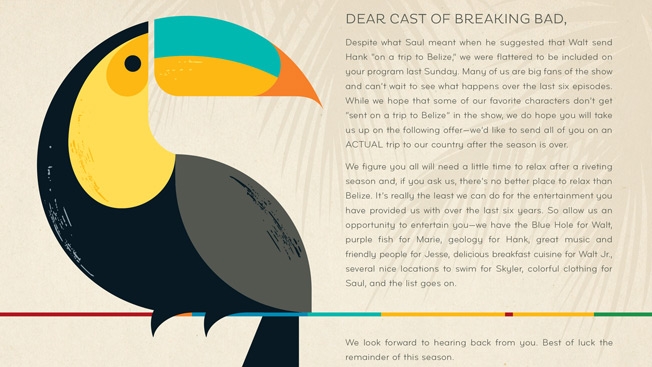
Taking "a trip to Belize" doesn't sound fun, at least the way the phrase was used on Breaking Bad last Sunday. But the small Central American country took the reference in stride and is out to prove that a visit to Belize isn't, in fact, a one-way trip to oblivion—by offering free vacations to Vince Gilligan and eight members of the AMC show's cast.
"Many of us are big fans of the show and can't wait to see what happens over the last six episodes," the tourism board (with help from ad agency Olson) wrote in its invitation. "While we hope that some of our favorite characters don't get 'sent on a trip to Belize' in the show, we do hope you will take us up on the following offer—we'd like to send all of you on an ACTUAL trip to our country after the season is over."
As Olson explained to us in an email, this is certainly a better response to the unflattering mention than just freaking out about it.
Hey @deanjnorris, not so nice what @mrbobodenkirk suggested last night. We’d love to have U for an actual trip anytime. #breakingbad #belize
— Belize Tourism Board (@belizevacation) August 19, 2013
![]()
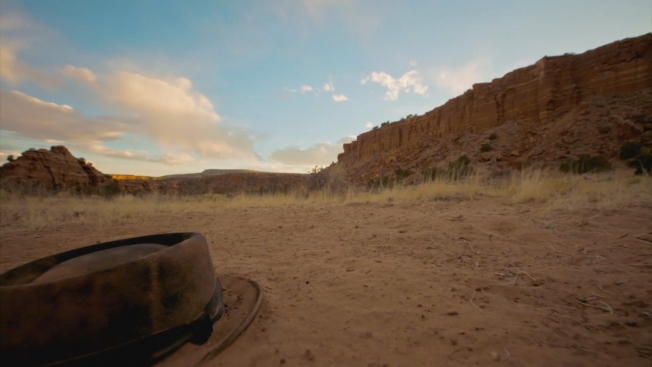
Breaking Bad wins the award for most poetic TV show promo ever. The final episodes of the series, beginning Aug. 11, are heralded by a haunting reading of "Ozymandias" by Bryan Cranston, aka Walter White, aka Heisenberg. Percy Bysshe Shelley's sonnet about the inevitable decline of kings serves as a warning to all those who would create an empire, suggesting time and nature will obliterate the works of man in the end. Given that Breaking Bad is a quintessential tragedy with all the trappings thereunto, including the inclusion of a Greek chorus, nothing could have been more perfect to foreshadow the end. Glad someone paid attention in 10th grade lit.
![]()
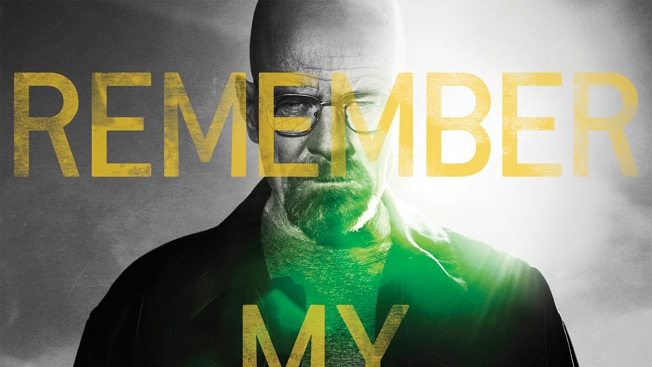
AMC on Tuesday released the official key art for the final eight episodes of Breaking Bad, premiering Aug. 11. "Remember my name," warns an intimidating, clenched-fisted Walter White, echoing the famous "Say my name" scene from the first half of Breaking Bad's fifth season. Beyond that, who knows what will happen as this great series comes to an end?
In more playful Breaking Bad news, AMC has also launched the Breaking Bad Name Lab, which allows you to see your name transformed with element symbols like the iconic Breaking Bad logo. You can then share the image on social media or download it as an animated GIF.
![]()